During the departmentation process, the organization faces difficulty selecting the most suitable ‘Types of Departmentation’.
In large organizations, besides the workforce, activities and processes are also diversified. As they grow in structure, managing personnel and tasks becomes challenging.
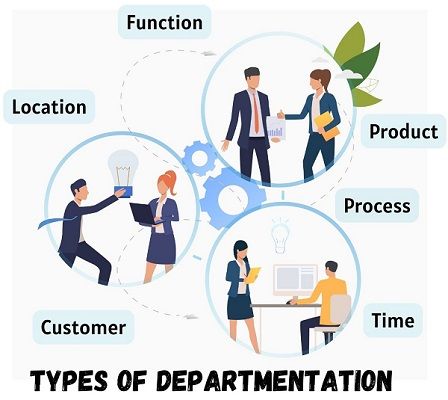
Thus, selecting the correct type of Departmentation is necessary to obtain desired results. As, it specifies the path for communication and ensures coordination across the organization.
Enterprises have various departmentation methods at their disposal. It is nothing but specific ways or bases based on which organizations group synonymous activities. Also, it helps top-level management in assigning authority and responsibility.
Organizations choose the appropriate method as per their short- and long-term objectives. Along with this, the enterprise’s character, type and size are also considered.
In this post, we have discussed the types of departmentation and their advantages and disadvantages in detail.
Content: Types of Departmentation
Types of Departmentation
Due to the variation in the type and nature of activities, several bases of Departmentation are available. The most common ones are as follows:
- Function
- Product
- Process
- Customer
- Time
- Location
Departmentation by Function
It is the most common method of Divisionalisation adopted by almost all organizations.
The division is based on the essential functions carried out by the organization. Consequently, the grouping becomes less complex and easy. This makes it suitable for all businesses.
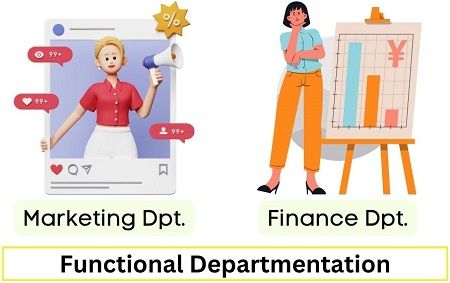
In this method, the top level creates a separate department for significant functions like Sales, Marketing, etc. Further, they subdivide these functions into minor or sub-functions.
Example
Marketing, Sales, Accounts, and HR Departments exist in most organizations. Moreover, each department has sub-divisions like Recruitment and Training in the HR department.
Advantages
- Suitable for all kinds of organizations.
- Creates efficiency throughout the organization.
- In-depth skill development.
- The top management has complete control over the organization.
- Various functional experts can be appointed.
Disadvantages
- Dispute or imbalance between the department heads.
- Less a number of all-rounder managers as they are specialists in their dedicated departments.
- A high degree of centralization and delayed decisions.
- Unsuitable product-specific enterprises.
- The manager develops tunnel vision.
- This form of Departmentation does not promote innovation.
Departmentation by Product
It is best suited for organizations with multiple product lines. It is usually observed in large manufacturing units offering multiple products.
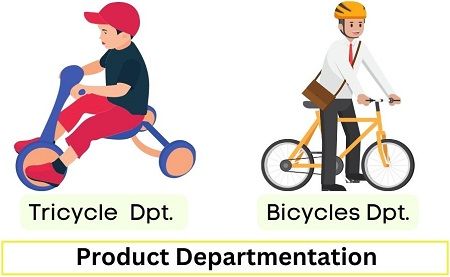
The division takes place in the form of autonomous units. Every unit is independent and headed by a product manager. Also, functional sub-divisions are created under each autonomous production unit.
Here, the activities are well-planned and synchronized. Along with this, there is clarity in accountability. The product manager is responsible for the success or failure of the unit.
When the market is highly competitive, this type of Departmentation is suitable. This is because, the managers can solely focus on the product they are responsible for.
Example
The Cycle manufacturing unit has separate units for kids and adult cycles. This is because the usage and design of both cycles are different. As, kids use a Tricycle, and adults go for a Bicycle.
Furthermore, these units have separate Marketing, Sales and Finance Departments.
Advantages
- Suitable for unstable environments & large organizations.
- It results in the production of high-quality products.
- Focus and attention towards product lines & services.
- Effective use of manpower.
- Recruitment of specialized staff for each function.
- Ensures better customer service.
- The easy distinction between performing and non-performing products.
Disadvantages
- A costly method as it requires manpower and other resources.
- Decentralization of authority and responsibility.
- Duplication of work and processes.
- Less coordination among the product lines.
- Standardization of processes is not possible.
- Competition between product heads.
- This may lead to the under-utilization of the plant’s capacity.
Departmentation by Territory
We can also call it Departmentation by Geographical location. This type of Divisionalisation is seen in enterprises where tasks are dispersed geographically.
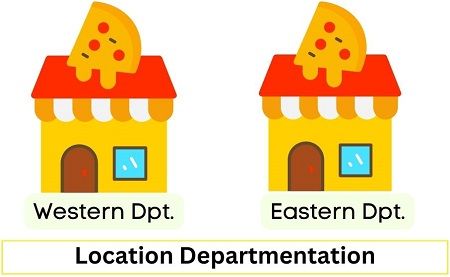
Organizations need to implement some business activities at their place of origin. So, it becomes challenging to manage widely dispersed activities from headquarters. Thus, they create regional divisions to achieve complete control over the activities and coordination.
Location departmentation gets benefitted from the local resources. In addition, managers can keenly analyze the customer’s demand and preferences. Furthermore, it significantly reduces transportation costs and builds goodwill in the market.
Example
The regional branches like Southern, Eastern or Western divisions of an MNC.
Advantages
- Get advantage of the local resources.
- Management and organization become easy.
- Can serve customers based on their regional tastes and preferences.
- It can save a significant amount of costs.
- Greater scope of expansion.
- Prompt action on local issues.
Disadvantages
- Companies need to employ a greater number of employees.
- Communication gaps between divisions may occur.
- It affects the overall profitability of the company.
Departmentation by Process or Equipment
Here, grouping takes place based on the manufacturing processes. In this method of Departmentation, similar types of labour and equipment are grouped together. However, it is suitable when processes require specialized skills.
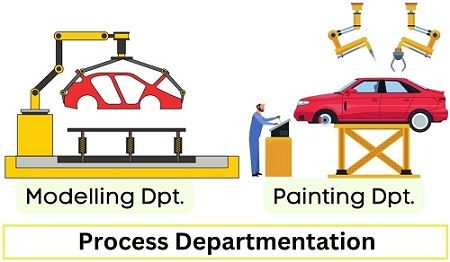
It groups people, equipment and resources to carry out a particular operation or process in one place. This enables departments to maintain the quality of operations and a high degree of coordination.
In addition, it facilitates deeper specialization to improve operating efficiency at each intermediate stage.
Example
In car manufacturing, there are separate departments for each process. For Example, Engineering, Modelling, Painting, Assembling and Servicing.
Advantages
- Planned and effective use of manpower.
- Appointment of skilled personnel.
- Clear and technical division of work.
- Effective use of manpower.
- Selection of expert staff.
Disadvantages
- Departments are interdependent, which can lead to clashes.
- A fault in one process can stop the entire production process.
- Employees don’t get the opportunity to upskill.
- There is a possibility of conflicts between project managers.
Departmentation by Customer
Consumer-wise Departmentation is helpful when grouping is based on the type of customer to be served. Management creates separate departments for a particular category of customers.
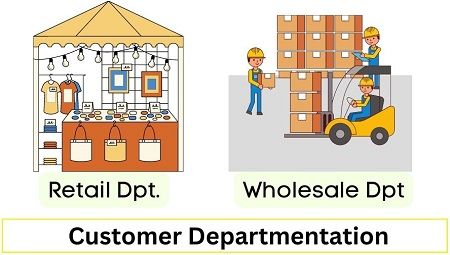
The managers are able to decode the customer’s preferences. By this, they can enhance their pre-& post-purchase experience.
However, it is impossible to group all the activities on this basis. But, it is suitable for the sales and marketing department.
Large enterprises with clearly defined customer groups can use this form of Departmentation.
It is majorly seen in the Book-publishing, Food and Banking industries. Organizations make different departments for their Retail, Wholesale or Distribution customers.
Advantages
- Understanding the needs of customers.
- Can focus on the target customers.
- Easy to regenerate sales by giving premium customer services.
- Improve goodwill and eliminate competition.
Disadvantages
- It is not possible to analyze all the customers.
- Customers’ tastes, preferences and choices differ.
- Production and sales head may get differences of opinion.
- Due to customization, production costs may increase.
- Emphasis is more on customer needs than optimization.
Departmentation by Time
In this type of Divisionalisation classification of activities is based on the performance time.
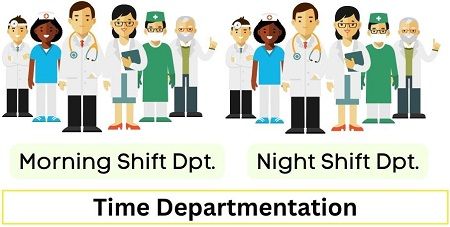
It is mostly seen in companies where production is carried out 24*7. This is because the workers need to work in shifts in such cases. So, units are created based on different shifts but perform various operations.
There are some reasons to carry out work in shifts:
- The machine can’t stop working before finishing the work.
- Continuous production is needed to meet high market demand.
- The services that the company is providing are essential in nature.
Example
Railways and Hospitals are an excellent example of time departmentation. Here, the people work in shifts like Morning, Evening and Night.
Advantages
- Increase in the volume of output.
- More number of working hours than usual.
- Efficient utilization of equipment and other resources.
- More recruitment due to work in shifts.
Disadvantages
- Difficulty in supervision during odd shifts.
- Less co-operation among workers.
- Chances of conflicts.
Parting Words
Among the above types of Departmentation, no single type is best. Organizations select one or a combination of methods which can yield them best results.
Leave a Reply